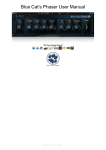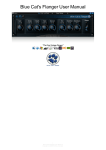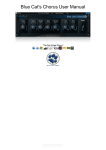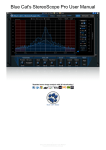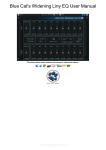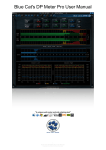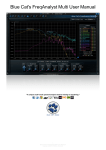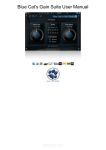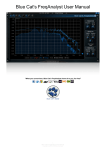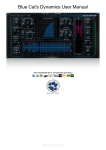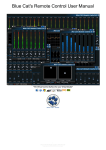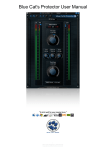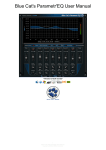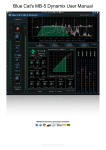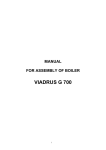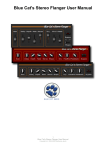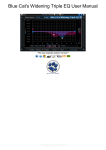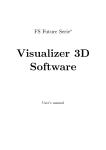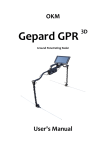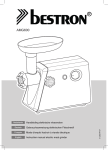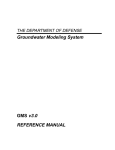Download Blue Cat`s Oscilloscope Multi User Manual
Transcript
Blue Cat's Oscilloscope Multi User Manual
"The all- at- once waveform visualizer and comparator."
1
Blue Cat's Oscilloscope Multi User Manual
Copyright (c) 2008-2015 Blue Cat Audio
Table Of Content
Introduction
Description
Features
System Requirements
Installation
First Launch
Using Blue Cat's Oscilloscope Multi
The User Interface
Operation
Blue Cat Audio Plug- ins Basics
User Interface Basics
Controls
Keyboard
Mouse
Presets Management
MIDI & Automation Control
More
Blue Cat's Oscilloscope Multi Parameters
Blue Cat's Oscilloscope Multi Curves
Plug- in Settings
The Global Settings Window
The Preset Settings Window
About Skins
Changing the Skin
Create a Custom Skin
Frequently Asked Questions
More
Extra Skins
Tutorials
Updates
Versions History
Note: An online version of this user manual is available here.
2
Blue Cat's Oscilloscope Multi User Manual
Copyright (c) 2008-2015 Blue Cat Audio
Note: An online version of this user manual is available here.
Introduction
Description
Blue Cat's Oscilloscope Multi is a unique multiple tracks real time waveform renderer and comparator: it lets you visualize the
content of several audio tracks on the same screen and compare them thanks to its X- Y view.
The plugin offers stereo or mid- side channels waveform extraction as well as several synchronization modes. The zooming and
precise measurement capabilities let you analyze the waveforms in details, and the XY phase scope view will help you track phase
issues within an effect chain or while recording with multiple microphones.
The additional histogram display complements the toolset to check the distribution of the values in the waveform and get an idea of
the average peak level.
The four memory slots let you store any waveform in memory: it helps you make comparisons between several setups or portions
of your audio project very easily.
Thanks to Blue Cat's skinning language support and the included window opacity management feature, you can adapt the plug- in
user interface to your personal needs and enhance your workflow.
Features
Main Features
Blue Cat Audio Standards:
Multiple tracks real time oscilloscope: visualize and compare the
Available as: Mac- AAX, Mac- AU, Mac- RTAS, Mac- VST, Win-
waveform of several audio tracks on the same screen.
Waveform display with loop, flow and trigger modes.
Histogram display.
Dual channel XY phasescope view (Lissajous) for easy phase
AAX, Win- DX, Win- RTAS, Win- VST, Win x64- AAX, Win x64DX, Win x64- VST.
Native DSP code for optimal performance.
Full MIDI control and automation support with silent, zipper- free
cancelation and mono compatibility issues detection on multiple
tracks or within an effect chain.
Latency compensation capability to align waveforms.
Choose a name for each curve for easier sharing.
Animated zoom for all displays.
parameters update, advanced response control and MIDI Learn.
No CPU load on idle: when the plug- in is fed with silence, the
processing smoothly shuts down, to optimize the CPU usage of
your Digital Audio Workstation.
Skinnable and customizable user interface with transparency
Precise measurement capabilities.
Save the curves for easy A/ B comparison.
Left- Right or Mid- Side operation modes
Unique data sharing technology with multi- core processors
management.
Smooth Bypass: activate/ deactivate the plug- in with absolutely
no noise.
Undo/ Redo.
support.
Opacity control for the user interface.
Full featured integrated presets manager.
Copy/ paste the plug- in's state between instances using the
system clipboard.
Any sample rate supported.
System Requirements
Windows
Mac OS X
An SSE2- enabled processor (Pentium 4 or newer).
Microsoft Windows XP, Vista, Windows 7, 8 or 10.
Any DirectX / VST / RTAS / AAX compatible host software (32 or
64 bit).
An Intel processor.
Mac OS X Yosemite (10.10), Mavericks (10.9), Mountain Lion
(10.8), Lion (10.7), Snow Leopard (10.6), or Leopard (10.5).
Any VST / Audio Unit (32/64- bit) / RTAS / AAX compatible
application.
For more information about supported platforms, see our FAQ.
Installation
The plug- ins versions cannot be run standalone: they require a host application (see the System Requirements chapter for more
information). Depending on which host application you use, you might need to install the plug- ins in different locations.
Before installing on of the plug- in versions, you will need to close all your host applications.
Windows
3
Blue Cat's Oscilloscope Multi User Manual
Copyright (c) 2008-2015 Blue Cat Audio
Install
All versions of the plug- in provide an installation program. Follow the steps of the wizard to install the software on your machine.
During the installation you will be asked where you want the software to be installed. For the VST version, you should install the
plug- in inside the VST plug- ins folder used by your host application(s). The default path set in the installer should work for most
applications, but you should check your host software documentation to know where it looks for VST plug- ins. For other plug- in
types, you should just use the standard path.
Some applications will not automatically rescan the new plug- ins, so you might have to force a refresh of the plug- ins list.
Upgrade
When a new version of the software is released, just launch the new installer: it will update the current installation.
Uninstall
To uninstall the software, simply launch the "Uninstall" program that is available in the start menu or in the configuration panel. It
will take care of removing all files from your computer.
Mac
Install
On Mac the plug- ins are available as drive images. After download, double click on the file to open it. You can then drag and drop
the file(s) to the shortcut that is provided within the image. It will install the software for all users on the machine.
In case you do not have admin rights on your Mac or if you want to install the software to another directory, just copy the files to the
appropriate location. If required, more information is available in the README.txt file that is included in the package.
Upgrade
When a new version of the software is released, open the new image and copy the files over the previous ones. The new version
will replace the older one.
Uninstall
To uninstall the software, simply remove the component(s) from the folder where you have copied them during install (move them
to the trash).
If you want to completely remove all settings and configuration files, you can also remove these additional directories that may
have been created on your computer:
~/ Library/ Preferences/ Blue Cat Audio/ [Plug- in name and TYPE], where TYPE is VST, AU, RTAS or AAX: global
preferences.
~/ Library/ Preferences/ Blue Cat Audio/ [Plug- in name]: license information
~/ Documents/ Blue Cat Audio/ [Plug- in name]: user data, such as presets, additional skins and user- created plug- in data.
Just beware that these directories may contain user data that you have created. Remove these directories only if you do not want
to reuse this data later.
First Launch
Blue Cat Audio plug- ins cannot be run standalone, they require a host application (see the System Requirements chapter for more
information). Some host applications will require you to scan the plug- ins before they are available in the application.
If the plug- in is not available in the application, please check that it has been installed in the appropriate directory (with no host
application running), and that the host application has scanned it.
4
Blue Cat's Oscilloscope Multi User Manual
Copyright (c) 2008-2015 Blue Cat Audio
Using Blue Cat's Oscilloscope Multi
The User Interface
Note: The main toolbar, menus and basic features available with all our plug- ins are detailed in the Blue Cat Audio Plug- ins
Basics section.
Blue Cat's Oscilloscope Multi plug- in is bundled with a single skin. You may want to create your own or download new ones from
www.bluecataudio.com. The included skin is composed of three panels:
The time view, where you can actually see the waveforms shared by all the instances of the plug- in.
The X- Y (or Lissajous) view, which lets you display X- Y plots of several waveforms to compare them and check their phase
relationship.
The routing pane where you can choose which analysis curve you want to display and share with other plug- in instances.
The main elements of the user interface are described below:
1. Choose between waveform and XY panes (to be displayed in (A)). Choose the display mode (single or dual screen). In dual
screen mode, you can show both the waveform and the XY panes at the same time.
2. Select the screen size (small, medium or large).
3. Show the routing matrix to select and rename the curves routed from this instance of the plug- in.
4. Synchronize all instances. Click here to trigger a synchronization between all instances of the plugin. You might need to use
this function to make sure all instances of the plugin are in sync. In some hosts applications the instances of the oscilloscope
might run out of sync (when the plugin is instantiated while audio is running, or sometimes at startup), showing out of phase
signals when it should not. This feature is useful to overcome such issues, and also to restart the signal flow when desired.
5. You can freeze all curves (for all instances) in order to get a snapshot of all the curves.
6. Select the stereo operation mode for the current instance. By default ('stereo') channel 1 is left and channel 2 is right. In 'MidSide' mode channel one becomes the mono part of the signal (Mid) and the scond channel is the stereo part of the signal
(Side).
7. Flow/ Loop/ Trigger: click here to change the display mode for all instances of the plugin.
8. Curves display settings:
Filled: show filled curves. This option may become CPU- heavy when you have multiple curves to display with a large
screen setting.
Antialias: antialiased curves look better (smoother), but you may want to disable this option if you prefer "old style"
display.
5
Blue Cat's Oscilloscope Multi User Manual
Copyright (c) 2008-2015 Blue Cat Audio
display.
Name: display the name of the curve on the graph (overlay).
Show List: display the list of available curves at the right of the current pane.
9. Delay compensation: this slider lets you add a delay to the waveforms generated by the current instance of the plug- in. You
can use it to align waveforms that you want to compare if they are not perfectly in sync.
10. These two sliders let you control the x and y zoom for the graphs in both views. Once zoomed, you can drag the rulers with
the mouse (click on the vertical or horizontal ruler when the cursor is a small hand and drag to move in the graph). It is also
possible to zoom the screen by selecting an area with the mouse. You can then right click on the graph to unzoom.
At any time, right click on the graph to unzoom.
The main parts of the user interface are the following:
(A) Current display (waveform or XY pane or both).
(B) This is the place where the coordinates of the mouse cursor are displayed when the mouse is over a graph.
The Routing Pane
In order to route curves to the display and share them among instances, you need to open the routing pane (by clicking on the
“Routing” button).
1. List of available curves for the current instance. These are the curves you can route to a shared curve numbered from 1 to
16. Their meaning depend on the stereo mode you have chosen: in stereo mode, channel 1 is left and channel 2 is right. In
Mid / Side mode channel 1 represents the mid channel (mono part of the signal) and channel 2 the side channel (stereo part
of the signal).
2. Select a shared curve slot to display and share the curve corresponding to the row.
3. When a slot is not available it means that it is already in use by this instance or another instance. You can click on the 'X'
button to free the slot occupied by the curve corresponding to the row.
4. When a slot is selected for an output waveform, it shows a blue border.
5. Use this button to reset all curves affectations for this instance of the plugin.
6. You can assign a name to each analysis curve. It will be displayed in the main pane when the curve is connected to a bus:
6
Blue Cat's Oscilloscope Multi User Manual
Copyright (c) 2008-2015 Blue Cat Audio
6. You can assign a name to each analysis curve. It will be displayed in the main pane when the curve is connected to a bus:
Waveform View
When first opening the plugin, the display pane is in 'Time' mode (waveform view). In this mode the plugin displays waveforms
(evolution of the audio signal over time) as well as an histogram of values for the waveform.
1. The main waveform display. It shows the evolution of the signal over time.
2. The histogram display. It shows the distribution of sample values for the waveform.
3. Select the shared curves to display. No curve will be shown on this view until you select the curves you want to share in the
routing pane. The curve names can be customized (see the routing pane).
4. The four “A B C D” buttons let you store the curve to one of the proposed memory slots. The curves stored into these slots
can be shown/ hidden with the buttons available in (5). This is useful when you want to store and compare waveforms.
5. Show/ Hide curves stored in memory.
6. In trigger mode, lets you select the trigger value.
About Display modes
The plug- in offers three display modes: flow (default), loop, or trigger.
In flow mode, the signal is reproduced "as is", flowing on the display as it is received by the plug- in. That's the default behavior,
which lets you seein real time the evolution of the waveform. The issue is that the signal may flow quite fast, so in some cases you
might need to freeze the display on a regular basis to take the time to look at the waveform.
In loop mode, the signal evolves from left to right and loops back to the begining as soon as it reaches the top right of the display. It
is much more "e;stable"e; for the eyes, but it does not offer the same flexibility and a much slower refresh rate when
zooming on a particular area.
7
Blue Cat's Oscilloscope Multi User Manual
Copyright (c) 2008-2015 Blue Cat Audio
If both loop and flow modes respect the absolute synchronization between instances, the trigger mode behaves differently. With
this mode you can specify the value as well as the direction used to sync the signals with the display. It means that the waveforms
displayed on the screen are not in absolute time sync anymore. So you should not try to measure absolute phase differences (the
Lissajous view typically does not mean the same thing). This mode is useful when looking in details at the shape of a waveform that
does not change much over time. It ensures that the waveform will not move too fast horizontally on the screen so that you can
focus on the shape of the signal.
The controls for the trigger mode are described below. They appear on the screen only when the trigger mode is selected:
1. Trigger mode selection.
2. Trigger value for all instances of the plug- in: this is the value that the plug- in will try to match for the last value displayed at
the right of the screen (it's the opposite from a traditional analog oscilloscope that uses the trigger for the left of the screen).
3. Trigger direction: up or down. That's the target direction of the waveform when it reaches the trigger value.
As an example, here is the same waveform as above, with ooposite trigger direction (up):
XY (Lissajous) View
In this mode, you can select several waveforms and analyze their relationship by displaying them on a single XY graph (you can
read more about X- Y analysis in the usage section):
8
Blue Cat's Oscilloscope Multi User Manual
Copyright (c) 2008-2015 Blue Cat Audio
1. Select the XY curves you want to display (2 curves are available for comparisons).
2. Store the curve to one of the memory slots.
3. For each XY curve, choose the waveform for the vertical axis (X)
4. For each XY curve, choose the waveform for the vertical axis (Y)
5. Show/ hide curves stored in memory slots.
6. Choose display options:
Connect Points: when this option is checked, points are connected by segments. Without this option, only dots are
plotted on the graph.
Time amount: this controls the portion of the waveform used for the XY display. With 100% the whole second you can
see in the time view is displayed. Reducing the amount of time lets you see instant changes, whereas increasing it
shows you a more averaged view of the waveforms over time.
Density: the larger the value, the larger the number of points are sampled and plotted on the graph. It is sometimes
necessary to adjust this value for a clearer display and better performance (the larger the value, the more CPU the
rendering requires).
Memory Curves
As shown earlier, it is possible save several types of curves in memory slots. Clicking on the little blue arrow below each memory
slot opens a menu to manage these curves: they can be copied and pasted to other slots (even in another application), or be saved
as files to be reloaded later:
Memory slot menu
This lets you make multiple measurements and reuse them elsewhere as references.
Screen Configurations
The plug- in is setup by default to work in single screen mode, but you can switch to dual screen mode using the display mode
button:
9
Blue Cat's Oscilloscope Multi User Manual
Copyright (c) 2008-2015 Blue Cat Audio
Dual screen mode
The various elements of the user interface (knobs, sliders, buttons...) are simple and intuitive to operate, but more information
about how to interact with them is available in the "Plug- ins Basics" chapter of this manual.
Operation
The Principle
Blue Cat's Oscilloscope Multi uses our unique data sharing technology to share complex information between several instances of
the plugin. This lets you visualize the shape of several audio tracks in the same plugin instance:
Each analyzer is both able to produce and display shared curves.
Multiple Instances Analysis
The procedure to compare the waveforms of several tracks is the following:
Insert the plugin one one or several audio tracks in your sequencer
10
Blue Cat's Oscilloscope Multi User Manual
Copyright (c) 2008-2015 Blue Cat Audio
For each instance, open the routing pane and select the curves you want to see and share.
Adjust the settings for the audio analysis in each instance.
Open the user interface of an instance of the plugin and select the shared curves you want to see.
Watch the result!
Note that in order to keep the waveforms synchronized you might have to restart the audio engine or playback after inserting all the
instances (it depends on your host application). You can also use the sync capability of the plugin to force all instances to
resynchronize and compensate the delay between waveforms thanks to the delay slider.
X- Y View
The X- Y view is a very simple tool to compare several waveforms. You can either use it to compare the waveforms for two
channels of the same track (typically left and right) or two waveforms of different tracks to see their relationship. A typical usage is
to check phase issues between several simultaneous recordings of the same song with different microphones or check the phase
of a stereo recording using Left and Right waveforms.
The principle is described hereafter:
Each blue dot corresponds to a sample value. Its x coordinate corresponds to the value of the waveform chosen for the X axis for
this sample, and the y coordinate corresponds to the value of the waveform chosen for the y axis for this sample. The display can
be divided into two zones:
1. In phase values: the values plotted in this area are in phase.
2. Out of phase values: the values plotted in this area are out of phase.
It is thus very easy to determine whether the waveforms are in or out of phase (see the examples in the table below). The relative
intensity of both waveforms is also easy to see on the graph: the closer to the X axis, the larger the relative value of the Y waveform
compared to the X waveform.
Note: for best results to compare phases between tracks, you should switch to “Loop Mode” which is more stable over time than
the “Flow Mode”. Do not forget to synchronize instances as well with the sync button, in case your host does not properly
synchronize processing chains itself.
11
Blue Cat's Oscilloscope Multi User Manual
Copyright (c) 2008-2015 Blue Cat Audio
Waveforms correlation and XY graph shape
Uncorrelated waveforms
Both waveforms have nothing in common. In this case the graph
shows a cloud with no particular direction.
In the case of a stereo signal (X=right, Y=left), it means that there will
be no phase cancellation when mixing both channels into mono, and
that the signal strongly sounds stereo.
Strongly correlated waveforms
On the graph shown here, both signals are identical. Signals that are
strongly correlated will display a similar shape, close to the Y=X axis.
In the case of a stereo signal (X=right, Y=left), it means that both
channels are strongly correlated, close to a mono signal.
Anti phase waveforms
The graph here shows two signals with opposite phase. Signals are
strongly correlated but if they are summed together, it will produce
silence.
For more information about how to use this plug- in in your favorite host application, have a look at the Blue Cat'sOscilloscope Multi
Tutorials.
12
Blue Cat's Oscilloscope Multi User Manual
Copyright (c) 2008-2015 Blue Cat Audio
Blue Cat Audio Plug- Ins Basics
This chapter describes the basic features that are common to all our plug- ins. If you are already familiar with our products, you can
skip this part.
User Interface Basics
About Skins
Like all Blue Cat Audio plug- ins, Blue Cat's Oscilloscope Multi uses a skinnable user interface. It means that the appearance and
behavior of the user interface can be entirely customized.
Especially with third party skins, the experience may be quite different from the one offered by the default skins that we provide.
However, our plug- ins and our skinning engine have several standard features that will be available whatever your favorite skin.
More information about custom skins can be found in the skins section.
The Main Toolbar
In most skins, an optional toolbar at the top of the user interface gives you access to the main options and settings of the plug- in:
Presets Area
At the center of the toolbar, you can see the current preset area (the "Default Settings" box). It displays the name of the current
preset, with a "*" at the end if it has been modified since loaded.
The arrows on the left and right let you navigate thru the (factory and user) presets available for the plug- in.
Clicking on the preset name opens the presets menu which lets you manage the presets of the plug- in.
Commands
The icons in the toolbar give you access the to the following commands that are detailed in the next paragraph:
Icon
Name
Function
Menu
Open the main menu
Undo
Undo
Redo
Redo
Manual
User Manual
About
About
The Main Menu
The main menu is available from the main toolbar, or if you right click anywhere on the background of the plug- in:
Presets: opens the presets menu to manage presets.
Preset Skin: opens the skins menu to choose the skin for the current preset and manage alternative skins for the software.
13
Blue Cat's Oscilloscope Multi User Manual
Copyright (c) 2008-2015 Blue Cat Audio
Preset Skin: opens the skins menu to choose the skin for the current preset and manage alternative skins for the software.
Undo/ Redo: undo or redo the latest modifications. This includes all changes made to the current preset settings such as
MIDI or automation preferences.
Presets Settings: open the presets settings window. It lets you change the skin, MIDI and automation settings for the
current preset.
Global Settings: open the global settings window. It lets you change the skin, MIDI and automation settings that are used
by default in all instances of the plug- in (if not overridden by the current preset).
User Manual: open this user manual.
Check for Updates: opens up our website to let you check if any update for this software is available.
Get More Skins: get more skins for this software.
Legal Information: browse licensing and misc legal documents.
About: displays the “about” dialog box.
The Title Bar
In most skins, an icon bar is located below the main toolbar. The first commands are the same for all plug- ins:
From left to right:
Smooth Bypass: smoothly bypass the plug- in (just like a power button).
Window Opacity: reduce the opacity value by turning the knob, and make the plug- in window transparent. (the result may
depend on the host application).
Show/ Hide MIDI and Automation Control Settings: show/ hide the buttons that give access to direct MIDI/ Automation
setup for each parameter in the user interface. This button will show or hide dropdown menu buttons that popup a MIDI/
Automation setup menu described here.
Controls
Examples
Here are a few examples of typical controls you will encounter in the user interface of our plug- ins:
slider
slider
knob
button
Text control
Interacting with Controls
You can interact with the controls of the plug- in interface either with the mouse or the keyboard.
Setting the keyboard focus on a control (so that it responds to key strokes) may be automatic (when you pass the mouse over it it
gets focus) or manual (you have to click on the control to set the focus on it). Note that all host applications behave differently
regarding keyboard handling. In some applications you may not be able to use all keys described later in this manual to interact
with our plug- ins. It is usually made obvious to you to know the active surfaces of the skin (the places where you can click with the
mouse): the mouse cursor usually changes when you can do something on a control. In the default skins delivered with the plug- in,
the cursor changes to a small hand or an arrow to tell you when your mouse is over an active control.
Mouse
Various mouse movements will let you interact with the controls:
14
Blue Cat's Oscilloscope Multi User Manual
Copyright (c) 2008-2015 Blue Cat Audio
Mouse Interaction
Action
Left Click
Acquire focus and start dragging or push (button)
Left Click + Alt Key
Set the value to default
Acquire focus and launch the “fine tuning” edit box (except button):
Left Double Click
Right Click
Set the value to default
Mouse Wheel
Increment or decrement the position (focus required)
Mouse Drag
Change the control position depending on mouse movement (except button)
Keyboard
All control widgets support the following keys (note that some of them are caught by the host and thus never forwarded to the
control. For example in Steinberg Cubase SX you cannot use the arrow keys to control the plug- in):
Keys Common to All Controls
Key
Action
Up Arrow
Small increment of the position (up or right)
Down Arrow
Small increment of the position (down or left)
Left Arrow
Same as Down Arrow
Right Arrow
Same as Up Arrow
Page Up
Large increment of the position (up or right)
Page Down
Large decrement of the position (down or left)
+
Small increment of the value of the control
-
Small decrement of the value of the control
d
Set to default value (same as mouse right click)
Opens the 'fine tuning' window to precisely set the parameter:
e
When the key is down, the fine tuning mode is on, and you can modify the value with
SHIFT
better precision when moving the mouse, the mouse wheel or using the keyboard.
Just release the key to get back to the normal mode.
Keys Specific to Buttons
Key
Action
Enter
Pushes the button
Presets
To get started with the plug- in and discover its capabilities, a couple of factory presets are provided. You can also save your own
presets and recall them later for other projects. Our plug- ins propose a full- featured preset manager to let you save, browse,
organize and recall its presets.
The Presets Menu
The presets menu can be opened from the main menu or the main toolbar. It displays the list of presets available for the plug- in as
well as commands to load, save or organize presets:
15
Blue Cat's Oscilloscope Multi User Manual
Copyright (c) 2008-2015 Blue Cat Audio
Factory Presets: shows the list of factory presets delivered with the plug- in.
"Folder A" to "User Preset Z": user presets and categories.
MIDI Program Change: activate MIDI Program Change support (see below).
Load: load preset from file.
Save: save current state to last loaded user preset.
Save As: save current preset to a file.
Copy copy preset to the system clipboard.
Paste paste preset from the system clipboard, if available.
Save As User Default: save the current state as the default preset. This preset is used every time a new instance of the
plug- in is created.
Clear User Default: reset the default preset to its factory state: this makes the plug- in forgets the custom settings you might
have saved as a default preset.
More about Presets
There are two types of presets: factory presets (read only) that are provided with the plug- in, and user presets that can be created
and stored by the user.
The user presets are stored in a subdirectory of the documents folders of your profile ("Documents" on Mac, and "My Documents"
on Windows): Blue Cat Audio/ [Plug- in Name]/ Presets. Each preset is stored as an individual file. You can create folders and
subfolders in the Presets directory to classify your presets, as shown in the example below:
If you save a preset named "Default" in the root Presets directory, it will override the factory default preset (that's what "Save As
Default" does). To restore the factory default preset, you can just remove this file or use the "Reset Default" command.
MIDI Program Change
It is possible to load presets remotely using MIDI "Bank Select" and "Program Change" messages. To enable this feature, select a
MIDI channel to receive the events from in the MIDI Program Change menu item from the presets menu:
16
Blue Cat's Oscilloscope Multi User Manual
Copyright (c) 2008-2015 Blue Cat Audio
This setting is a global preference (shared accross all instances of the plug- in). Once activated, the plug- in menu will display the
bank number followed by the preset number for each preset:
Every root folder is considered as a new bank, starting with the factory presets (bank 0). Program and bank numbers may change
while you add folders and presets, so you should be careful when naming them if bank and program numbers matter to you. It is
recommended to use folders to make this task simpler. As a side note, sub folders do not define additional banks (all presets
contained in sub folders are associated with the current bank.
As specified by MIDI, bank select messages are not used until a program is actually selected.
MIDI Implementation note: the software supports all types of Bank Select methods. You can use either MIDI CC 0 or MIDI CC 32
to select banks. If both are used simultaneously, they are combined together so that you can use more banks (in this case CC0 is
LSB and CC32 is MSB, and actual bank number is 128*CC0+CC32).
MIDI and Automation Control
Blue Cat's Oscilloscope Multi can also be remotely controlled via MIDI using MIDI CC ("Control Change") messages or automation
curves, if your host application supports it. It is possible to customize the channel, control numbers, range and response curve
used for each parameter in the settings panel available from the main menu (see the Plug- in Settings chapter for more details).
MIDI and Automation Settings Menu
Most skins also provide the ability to change MIDI and automation settings for each parameter directly in the main user interface.
When this feature is activated using the corresponding title bar button, dropdown menu buttons appears next to main controls:
Clicking on this button shows the MIDI/ Automation settings menu:
17
Blue Cat's Oscilloscope Multi User Manual
Copyright (c) 2008-2015 Blue Cat Audio
MIDI Learn: launches MIDI learn mode for the control: touch your MIDI controller and the control will learn from it the MIDI
channel and CC number. To end the learn mode, reopen this menu and deselect the option.
MIDI Unlearn: deactivates MIDI control for this parameter.
Settings: launches the advanced settings panel described below. This controls the settings for the current preset.
Advanced MIDI and Automation Settings
You can completely customize the way the plug- in is controlled by automation and MIDI. For a global view of all parameters at a
time, you can use the Plug- in Settings window for the current preset which is available from the main menu.
MIDI Settings:
Enable MIDI: enable/ disable the MIDI control of the parameter.
Channel: MIDI Channel for the parameter control. If set to 0, the plug- ins will accept Control Change Messages from all
MIDI Channels (MIDI Omni mode).
CC: Control Change Number.
Learn: click on this button to activate the MIDI learn functionality. When it is activated, you can move your MIDI controller,
and the plug- in will automatically set the MIDI Channel and CC Number.
MIDI and automation settings:
Response: response curve of the MIDI or automation control: from very fast to slow control.
Min: minimal value of the parameter when MIDI controlled or automated.
Max: Maximum value of the parameter when MIDI controlled or automated.
Note: if the Min value is higher than the Max value, the response curve will be reversed: increasing the control value will decrease
the parameter value.
Note: if you double click on the parameter text control boxes for the max and min values, a “fine tuning” edit box will appear and let
you change the min and max values with more precision:
More
Check our online tutorial for more screenshots and more examples of our plug- ins user interfaces.
18
Blue Cat's Oscilloscope Multi User Manual
Copyright (c) 2008-2015 Blue Cat Audio
Blue Cat's Oscilloscope Multi Parameters
All parameters described below can be automated and controlled via MIDI if your host application supports it. You can precisely
define this behavior in the settings panels described later in this manual.
The input parameters of this plug- in are described below. They affect the audio analysis for the current instance of the plug- in.
Param id
Name
Unit
Description
dsp.input0
Bypass
Bypass the plugin.
dsp.input1
Stereo Mode
This parameter controls the channels used for waveforms in
the current plugin. 'Stereo' uses Left and Right channels and
'Mid- Side' adds an MS matrix to display Mid and Side
channels waveforms.
dsp.input2
View Mode
Controls the way the data is fed into the output curves: in
'Flow' mode, the waveform flows in real time (each new
sample pushes the older samples to the past), whereas in
'Loop' mode, the new samples loop back to the beginning of
the wavefor when the one second buffer is filled.
dsp.input3
Sync
dsp.input4
Delay
Any change in value of this parameter triggers a
synchronization of the instance: the waveform display
restarts at this point.
ms
Delays the waveform of the current instance. It can be used
to compensate the delay between signals that are not in
sync.
19
Blue Cat's Oscilloscope Multi User Manual
Copyright (c) 2008-2015 Blue Cat Audio
Blue Cat's Oscilloscope Multi Curves
The Oscilloscope Multi plug- in's main purpose is to provide visual feedback about the audio content of the audio signal. This is
done thanks to several output curves that can be routed to one of the 16 display curves. The plug- in has two channels. In stereo
mode, channel 1 is left and channel 2 is right. In Mid / Side mode channel 1 represents the mid channel (mono part of the signal)
and channel 2 the side channel (stereo part of the signal).
Curve id
Name
Description
dsp.output_curve0
Instant Waveform (1)
Instant audio content for channel 1.
dsp.output_curve1
Instant Waveform (2)
Instant audio content for channel 2.
20
Blue Cat's Oscilloscope Multi User Manual
Copyright (c) 2008-2015 Blue Cat Audio
Plug- in Settings
In addition to the controls offered in the main user interface, Blue Cat's Oscilloscope Multi has various settings that let you fine tune
the behavior of the plug- in. You can choose to change these settings either for the current preset or globally for all instances of the
plug- in.
The Global Settings Window
The settings available in this window apply to all instances of the plug- in, for all presets, if not overridden in the presets
settings. Consider these settings as “default” settings.
General
You can change the default skin for all instances of the plug- in: write the skin file path in the text edit box or click on the button to
open a file chooser dialog. If you have several instances of the plug- in opened in your session, you will have to re- open the user
interfaces of these plug- ins to see the skin change.
The output data refresh rate can also be customized for all instances of the plug- in. It controls the refresh rate of non- audio data
produced by the plug- in (parameters, curves...). It also controls the refresh rate of output MIDI CC messages or output automation
data. The higher the refresh rate, the better precision, but also the higher cpu usage (some host applications may also have trouble
recording MIDI data at high refresh rates). The default value is 50 Hz.
Global Control Input Settings (MIDI and Automation)
The plug- in offers a couple of settings that affect the way it is controlled by MIDI messages or automation. While the first settings
only apply to MIDI control, the "Control Response", "Min" and "Max" settings apply to both automation and MIDI control.
For each parameter you can define a default MIDI channel and CC number. You can then control the plug- in with an external MIDI
controller or one of our plug- ins that generate MIDI messages.
The settings below are available for each plug- in parameter.
MIDI Settings:
Enable MIDI: enable/ disable the MIDI control of the parameter.
Channel: MIDI Channel for the parameter control. If set to 0, the plug- ins will accept Control Change Messages from all
MIDI Channels (MIDI Omni mode).
CC: Control Change Number.
21
Blue Cat's Oscilloscope Multi User Manual
Copyright (c) 2008-2015 Blue Cat Audio
CC: Control Change Number.
Learn: click on this button to activate the MIDI learn functionality. When it is activated, you can move your MIDI controller,
and the plug- in will automatically set the MIDI Channel and CC Number.
MIDI and automation settings:
Response: response curve of the MIDI or automation control: from very fast to slow control.
Min: minimal value of the parameter when MIDI controlled or automated.
Max: Maximum value of the parameter when MIDI controlled or automated.
(generic screen shot, does not correspond to the actual plug- in parameters)
Note: if the Min value is higher than the Max value, the response curve will be reversed: increasing the control value will decrease
the parameter value.
Note: if you double click on the parameter text control boxes for the max and min values, a “fine tuning” edit box will appear and let
you change the min and max values with more precision:
The Current Preset Settings Window
In this window you can change the settings for the current preset of the current instance of the plug- in only.
Preset Skin
You can choose to use the global skin setting or to change the skin for the current preset. This way you can have different skins for
different instances of the plug- in in the same session in order to differentiate them.
22
Blue Cat's Oscilloscope Multi User Manual
Copyright (c) 2008-2015 Blue Cat Audio
Preset Control Input Settings (MIDI and Automation)
Use the global settings or override them for the current preset. The parameters are the same as for the global input settings.
(generic screen shot, does not correspond to the actual plug- in parameters)
23
Blue Cat's Oscilloscope Multi User Manual
Copyright (c) 2008-2015 Blue Cat Audio
(generic screen shot, does not correspond to the actual plug- in parameters)
About Skins
Blue Cat's Oscilloscope Multi integrates Blue Cat's skinning engine that allows you to customize the user interface. You can
download alternate skins for your plug- in at the following address:
http:// www.bluecataudio.com/ Skins/ Product_OscilloscopeMulti
If you don't find a skin that fits your need or if you want a custom one, you can choose to create your own skin.
Choosing the Skin
There are two ways to select the skin of your plug- in: you can change the default (or 'global') skin, or change the skin for the
current preset only (either in the preset settings page or from the main menu). The global skin applies to all plug- in instances
(choose this one if you want to use the skin used by default, regardless of the session or preset), whereas the current preset skin
only applies to the current preset of the current plug- in instance (use this one if you want to change only the skin for the current
session/ preset).
Note: in some host applications, the plug- in window won't resize automatically when you choose a skin with a different size. In this
case, just close the window and re- open it: it will be displayed with the right size.
The Skins Menu
The skins menu can be opened from the main menu. It displays the list of skins available for the plug- in as well as commands to
manage the skin used by default when no preset skin has been selected:
First Section - Factory Skins: shows the list of factory skins delivered with the plug- in ("Default" and "Light" in this
example).
Second Section - User Skins: shows the list of user skins that have been installed in the Documents Skins folder for the
plug- in (see below).
Use Global Skin: use the global skin for the current preset/ session (unloads any custom skin previously selected for the
current preset).
Load: opens a file browser dialog to manually select the skin from the file system.
Save As Global Skin: use the current preset skin as the global skin (loaded by default if no preset skin has been defined).
Installing User Skins
If you want to be able to select user skins directly from the skins menu, you simply need to install them in the Skins directory
available in the plug- in's documents folder:
[Your Documents Folder]/ Blue Cat Audio/ [Plugin Name]/ Skins/
The skin engine will scan this folder for new skins (xml files) and display them in the menu. The skin files should be in the root skins
folder or in a subdirectory inside this folder: subdirectories are not scanned recursively.
Other Methods to Select Skins
You can also select the skins in the settings panels available from the main menu:
The global skin (used by default if no preset skin has been selected) can be changed in the global settings pane. The current
preset skin can be changed in the preset settings page.
Create a Custom Skin
24
Blue Cat's Oscilloscope Multi User Manual
Copyright (c) 2008-2015 Blue Cat Audio
You can create custom skins for your plug- in in order to adapt it to your exact needs. You can change its look and feel and make it
completely integrated in your virtual studio!
Just read the Blue Cat's Skinning Language manual and download the samples for the tutorial on http:// www.bluecataudio.com/
Skins. You can get ready to create your own skins in a few minutes.
You can then share your skins on our website.
25
Blue Cat's Oscilloscope Multi User Manual
Copyright (c) 2008-2015 Blue Cat Audio
FAQ
Troubleshooting
I have opened my plug- in and nothing appears on the curves display
Before any curve may appear on the display you need to open the “Routing” panel and route a curve to the shared curves bus. To
do so, choose a source curve and destination curve in the routing matrix.
If nothing appears, check that the audio engine of your host application is running and that the plugin is fed with a non silent audio
signal. Another cause of seeing nothing on the display is that you may have unselected the curves on the right of the main view.
Click on the “show all” link to activate the display.
The display randomly losts sync and my signals appear out of phase
This may happen in some particular host applications with specific hardware configurations. In this case first try to synchronize the
instances with the sync button. It the signals still appear out of phase whereas you know they should not, you might want to switch
to loop mode that is more stable over time. In order to detect phase problems it is the recommended setting since synchronization
between tracks is much more stable with this mode.
Note that a specific issue exists with Ableton Live on the Mac: if you compare the signal of several instances on the same track,
they will appear with a delay equal to the processing buffer size. This is not an issue in most cases, except if you are trying to track
phase changes in a processing chain. We are aware of this issue and are working on it to find a solution. If you encounter this
problem, you can use the delay compensation feature of the plug- in to compensate the delay introduced by the host and keep
waveforms in sync.
Plug- ins Formats
What are DirectX (DX), Audio Unit (AU), RTAS, AAX and VST plug- ins?
VST, Audio Unit, RTAS, AAX and DirectX plug- ins are software components than can be used in "Host" Software (such as Blue
Cat's PatchWork, Pro Tools, Cakewalk Sonar, Steinberg Cubase or Wavelab, Sony Vegas, Logic Pro, Garage Band, Ableton
Live...) in order to perform some MIDI and/ Or Audio real- time Processing tasks. To be more precise what we usually call directX
plug- ins is actually a "DirectShow Filter". VST is owned by Steinberg, DirectX by Microsoft while Audio Units is the property of
Apple Computers and RTAS and AAX are owned by AVID.
How can I use your plug- ins?
Download and install a host software, then download and install the plug- ins from our page. They will appear in the host "effects"
menu. If you are using a DirectX host with our MIDI controllable plug- ins and they do not show up in you host list, you might need
to use our freeware DXi Manager. Note that our plug- ins are sometimes shown in the "MIDI controllable audio effects" or "soft
synths" sections in some host applications.
Where can I find a host?
You use Blue Cat's PatchWork standalone application to host any VST or Audio Unit plug- in for real- time operation. There are
also many commercial or freeware hosts that will suit your needs. You can find a long list of applications here. You can also use
demos of Cubase, Wavelab, Ableton Live, Tracktion, or Sonar software, which are usually available on the companies websites.
On the Mac, Garage Band is part of the system and can be also used to host our Audio Unit plug- ins.
What are the main differences between DX, VST, RTAS, AAX and Audio Units?
VST is a protocol that works on several platforms (Mainly Windows, MacOS, BeOS, and some Linux platforms use it as well)
whereas DirectX is Microsoft Windows only, and Audio Units are available only on the Mac. RTAS and AAX are available on Mac
and PC, but only for Pro Tools products (AVID). AAX plug- ins are compatible with Pro Tools 10 and higher, whereas RTAS
versions are compatible for Pro Tools 10 and lower versions.
What is the difference between DXi and DX effects?
DXi effects are MIDI controllable DirectX plug- ins. It's the same as DX effects plus MIDI control.
Which version (VST, Audio Unit, RTAS or DX) should I use in my host application?
Here is a list of host software and the version we recommend you to use. Many other applications are supported, check your
application user manual to choose the best version (AU stands for "Audio Unit" and DX for "DirectX"):
26
Blue Cat's Oscilloscope Multi User Manual
Copyright (c) 2008-2015 Blue Cat Audio
Host Application
Plug- in Version
Cakewalk Products (Sonar, Project5...)
VST for Sonar 8 and newer, DX for older
Sony Products (Vegas, ACID, Soundforge)
VST
Steinberg Products (Cubase, Nuendo, Wavelab)
VST (Mac or PC)
Ableton Live
VST (Mac or PC)
Adobe Audition
any
EnergyXT
VST
Magix Samplitude
VST
Avid (Digidesign) Pro Tools
RTAS for PT 9 and earlier, AAX for PT 10 and newer
Apple applications (Logic Pro, Logic Express, Garage Band...)
AU
Cockos Reaper
VST (Mac or PC)
...
In general, we recommend using VST over Audio Unit on Mac (when both are supported), particularly for the plug- ins that can
output automation or MIDI CC messages.
Where can I find more information about this topic?
www.steinberg.net
www.microsoft.com
www.kvraudio.com
www.apple.com
www.digidesign.com
Installation
I have installed my software and it is not listed as an application. Why? What can I do? How can I launch it?
Most software you can purchase on this website is plug- ins for host applications. It means you need another application to use it.
See the "Plug- ins Formats" section in this FAQ for more information.
I have installed my plug- in and it does not show up in my host application. What can I do?
First check that you application supports DirectX, Audio Unit or VST plug- ins.
If you are using the DirectX version, check that your host application supports DXi plug- ins (MIDI enabled DirectX plug- ins). If it
does not, it may remove it from the DirectX plug- ins list (some applications such as Sony Vegas 5 and Cool Edit Pro are known to
do this). In this case, use our DXi Manager free utility and disable the MIDI capabilities of the plug- in. You may need to reinstall the
software again before it shows up into your host application. For more information about this topic please read our DXi in Sony
Vegas tutorial (it is applicable to other applications than Sony Vegas).
If you are using the Direct X version and your host application supports DXi, check that the plug- in does not appear in the 'virtual
synth' or 'synthesizers' category. If you wish not to use the MIDI capabilities of the plug- in and use it as a regular Direct X plug- in,
you can download the freeware DXi Manager and disable the MIDI capabilities of the plug- in.
I have installed my plug- in on windows 64- bit, checked the items above, and it still does not show up in my host
application. What can I do?
You are probably running a 32- bit application. If that's the case, you need to install the 32- bit version of the plug- in: the choice for
32 or 64- bit is not determined by the operating system (64- bit windows can run both 32 and 64- bit applications), but by the host
application that you are using.
Why are there two plug- ins called xxxx(Mono) and xxxx(Stereo) installed ?
27
Blue Cat's Oscilloscope Multi User Manual
Copyright (c) 2008-2015 Blue Cat Audio
"Mono effects" (which are effects that do not make any difference between left and right channels) are bundled this way for
performance reasons. Some developers just deliver a stereo Version which also processes (twice) mono streams. The "(Mono)"
plug- in is to be used with mono streams, and the (Stereo) one with stereo streams. The effect itself is the same in both cases but
the number of processed channels is different: this may drastically improve performance for CPU intensive plug- ins.
How do I uninstall my plug- ins?
Open the Windows configuration panel/ Add Remove Programs, and choose 'Remove' on the corresponding plug- in. If you have
installed the VST plug- in zip file version, just delete the corresponding dlls.
Why do your plug- ins need an installer on Windows? Do they modify the registry or system settings? Why not providing
just a dll?
Our plug- ins require several additional files for default settings, skins and miscellaneous data. We provide an installer for our
customers' convenience. Our installers do not modify the system settings or the Windows registry, except for the DirectX versions
registration. Our installers won't harm your system.
Software Version
How do I know the version of the plug- in I am using?
You can see the version information in the about box: right click on the background of the plug- in user interface and select "About".
The product version is also available in the Windows Add/ Remove Programs Window.
Why do newer versions of a plug- in override older ones (they have exact same name and IDs)?
Because newer versions improve previous ones. When a new version is released, older versions are not supported anymore. In
some cases the new versions may be installed as new products (compatibility reasons, major changes...), but it is explicitly
documented on the product page.
A new minor version of a product I purchased some time ago is available. Where can I download the update?
The new version can be downloaded from the same place where you downloaded the original version. All information is contained
in the email you received when you purchased the product. Your registration number has not changed either.
Upgrade
A new minor version of my plug- in has been released. Where can I download it?
When you purchased the plug- in, an email containing the information to download and register your software has been sent to
you. You can download the new version from the exact same location as the first time.
I have downloaded a new version, do I need to uninstall the previous version?
No, you don't, except if it's specified on the product page, in the "history" section. Just run the installer and it will upgrade your
software.
Automation
What is "Parameters Automation"?
The parameters of an effect can be automated in most host software. It means that you can record the changes you do during
playback or recording so that it's replayed when playing back again. It's a way of sequencing parameters changes the same way
you do with Audio or MIDI data.
What is "Smooth Update"?
When changing parameter values in real time or replaying a song where parameters have been automated, our plug- ins compute
intermediate values between parameter changes in order to avoid "clicks" and "pops" that may occur otherwise. It results in a non
audible smooth parameters update and lets you freely use automation or MIDI control to change the effects in a song.
Do your plug- ins support MIDI Control?
Yes they do. They offer precise control over the mapping of MIDI Control Change (CC) messages to parameter values: you can
adjust both the channel and CC number as well as the response curve of the control. Since some of our plug- ins are also capable
of creating MIDI CC from the audio signal, they can all be connected for real time signal- dependent audio effects. See our MIDI
Control in Sonar tutorial for an example.
28
Blue Cat's Oscilloscope Multi User Manual
Copyright (c) 2008-2015 Blue Cat Audio
More...
This manual only covers the basics of Blue Cat's Oscilloscope Multi. Our website offers many additional resources for your Blue
Cat's Oscilloscope Multi plug- in and is constantly updated, so keep an eye on it! You will find below a few examples of available
resources.
Extra Skins
We encourage our customers to propose their own skins for our products and we often propose alternative skins to let you choose
the one that best suits your needs. You can check Blue Cat's Oscilloscope Multi skins page to get the latest skins.
Large Screen (for V1)
Product: Oscilloscope Multi
Description: A skin with a very large screen for the oscilloscope v1 (version 2 lets you choose the
size). You can customize the actual size by changing the numbers in the screen_size.inc text file.
Author: Blue Cat Audio
Download: Skin_Large.zip
Small Screen (for V1)
Product: Oscilloscope Multi
Description: A skin with a smaller screen for the oscilloscope v1 (version 2 lets you choose the
size). You can customize the actual size by changing the numbers in the screen_size.inc text file.
Author: Blue Cat Audio
Download: Skin_Small.zip
Tutorials
Many Tutorials are available on our website. They cover a wide range of topics and host applications. You will find below a list of
tutorials that are related to the Blue Cat's Oscilloscope Multi plug- in. An updated list is also available online.
Tutorial - Customize the Colors of your Plugins
This tutorial shows how to customize the FreqAnalyst Pro plugin's user interface by changing the
color of the displayed curves. It is a very basic skinning tutorial. All you need to know is how to
exp...
[Read More...]
Tutorial - Blue Cat's Oscilloscope Multi Video Overview and Tutorial
A review and tutorial of Blue Cat's Oscilloscope Multi plugin for Windows and Mac VST, AAX,
RTAS, AU, and DirectX platforms by Real Home Recording. Main topics covered in this video:
fixing phase co...
[Read More...]
Tutorial - Monitoring an effect chain with the 'Multi' Series
The 'Multi' analysis plugins series offer the ability to compare the measurements made by several
instances within an audio project. In this tutorial you will learn how to use this capability to mon...
[Read More...]
Tutorial - Multiple Tracks Real Time Spectrum Analysis
29
Blue Cat's Oscilloscope Multi User Manual
Copyright (c) 2008-2015 Blue Cat Audio
In this tutorial you will learn how to use the multiple instances features of the FreqAnalyst Multi
spectrum analysis plugin to provide you with visual help for mixing. This tutorial is based on a ver...
[Read More...]
Tutorial - How to Use the Free Presets Available on this Website
This tutorial shows you how to get and load free presets for your favorite Blue Cat Audio plugin.
This tutorial uses Blue Cat's Dynamics for the demonstration but is applicable to all our plugins...
[Read More...]
Tutorial - Getting Started with Plug- ins User Interface
Get used to the user interface features of Blue Cat Audio products! They have been designed for
an optimal workflow, so here are the tips and tricks to save time. All these features are explained in
d...
[Read More...]
Tutorial - Using DXi plug- ins in Sony Vegas
This tutorial will teach you how to use any DXi plug- in in Sony Vegas: Sony Vegas does not
support MIDI automation, so if your plug- in supports the MIDI Dxi protocol, it is removed from the
plug- ins l...
[Read More...]
Tutorial - Export Plugin Presets to Share them with the Community
This tutorial shows you how to export your presets in order to share them with the community on
the Blue Cat Audio website. This tutorial uses Blue Cat's Stereo Triple EQ for the demonstration
bu...
[Read More...]
Tutorial - Using MIDI Control in Sonar
This tutorial will help you understand how to use parameters MIDI control in Cakewalk Sonar. It is
applicable to any DXi plug- in (MIDI enabled DirectX plug- in)....
[Read More...]
Updates
As you can see in the history log below, we care about constantly updating our products in order to give you the latest technology
available. Please visit our website often to check if Blue Cat's Oscilloscope Multi has been updated, or subscribe to our Newsletter
to be informed of the latest news about our products.
You can also follow us on twitter and facebook for almost real time updates notification, and subscribe to our YouTube channel to
see the latest videos about our software.
30
Blue Cat's Oscilloscope Multi User Manual
Copyright (c) 2008-2015 Blue Cat Audio
Versions History
V2.1 (2015/09/07)
Save each memory curve as a file that can be reloaded later as a reference.
Copy and paste memory curves between instances using the system clipboard.
Last loaded preset can now be saved directly from the presets menu without having to select the file.
Fixed demo version popup window freezing Pro Tools in some situations.
Presets can now be selected using MIDI Program change and bank select messages (can be activated with the presets
menu/ MIDI Program Change item).
Factory and user skins can now be selected directly from the plug- in menu.
V2.03 (2014/01/09)
New Features:
Copy/ paste the plug- in's current state from the presets menu using the system clipboard.
Improvements:
Reduced the plug- in's memory usage.
Windows VST Installer now remembers where the plug- in was initially installed to simplify upgrades.
(Mac) plug- in version number is now available when using "Get Info" in the Finder.
(Mac) Improved display of Audio Unit parameters in most host applications.
Bug Fixes:
Fixed window frame not showing with Cubase 7.5 (32- bit) on Mac.
(Mac) About window does not show up first in the corner of the screen anymore.
(Win) Alt- Click on a control now resets the value to default in Pro Tools, as expected.
Fixed version number reported to host application for VST and Audio Unit versions.
V2.02 (2013/06/21)
64- bit AAX support for Pro Tools 11.
V2.01 (2013/05/14)
Bug fixes:
Fixed AAX version not showing up in Pro Tools 10.3.5 on Windows.
(RTAS) Fixed parameters control with EUCON control surfaces in Pro Tools.
Fixed user interface issues in Final Cut Pro X.
Fixed compare button issues in Pro Tools.
Fixed MIDI and automation settings that were reset when using undo.
Mac- VST: Fixed window resize issues on Cubase and Nuendo (Mac).
Mac: Fixed user interface display issues when first opened in Ableton Live 9.
Mac: Control MIDI settings dialog now brought back to front when already opened in the background.
Mac: fixed copy/ paste keyboard shortcuts for plug- in registration that did not work in some hosts.
V2.0 (2012/10/22)
New Features:
Brand new fully customizable user interface:
New look and feel.
Show/ hide what you need.
Curves names can now be displayed on the graphs (overlay).
Single or multiple displays modes.
Multiple display sizes
Improved readability.
Animated transitions.
XY curves can now be saved in memory slots.
XY curves can now use waveform memories to compare with saved waveforms.
New integrated presets manager:
Load/ save presets from the plug- in's user interface.
Organize presets with folders.
Customize the default preset.
Exchange presets easily.
Automation range and response curve can now be customized for each parameter.
AAX plug- in format is now also supported on Windows (Pro Tools 10.2 required).
Improvements:
Improved Graph rulers display when zoomed.
Routing matrix automatically displayed when opening the plug- in for the first time for easier setup.
New presets to make setup easier.
Plug- in name has been shortened for a clearer display in mixer view for most host applications.
The windows installer now automatically detects the most appropriate VST install path.
License is now shared between plug- ins types (register only once for all formats).
Added new presets.
Improved value display in fine edit window.
Optimizations and Performance Improvements:
Reduced VST plug- in loading time.
Improved parameters precision (now stored as 64- bit).
More compact presets format (uses less space and loads faster).
Smaller binaries on Mac (dropped PowerPC support).
Bug Fixes:
Fixed presets- related crashes in Cubase on Mac.
Fixed user interface display issues in Wavelab on Mac.
Fixed keyboard stealing issue in Digital Performer 7 on Mac.
31
Blue Cat's Oscilloscope Multi User Manual
Copyright (c) 2008-2015 Blue Cat Audio
Fixed keyboard stealing issue in Digital Performer 7 on Mac.
AAX/ RTAS on Mac: Fixed audio engine freeze or error issue with Pro Tools on some Mac configurations.
Note: this new version can be installed side by side with the previous version for backward compatibility reasons. Installing this
new version won't break your previous projects.
V1.7 (2011/07/11)
Output data rate can now be customized, from 20 to 500 Hz.
Increased the default output data rate (from 20 to 50 Hz) for smoother curve display.
New trigger mode: the oscilloscopes can now be synced using a trigger, based on the value and direction of the incoming
audio signal.
Windows: improved settings dialog loading time.
Mac: user interface performance improvement (up to 30% lighter on cpu).
V1.62 (2011/02/10)
Fixed keyboard focus stealing issue in Pro Tools and several other host applications.
V1.61 (2010/11/29)
Fixed incompatibility issues with older presets in the previous version.
V1.6 (2010/11/18)
New histogram view.
New delay compensation feature to compare out of sync waveforms.
64- bit Mac VST support.
User interface enhancements:
Improved readability.
Zooming is now animated.
You can now directly drag rulers when zoomed: no need to select the drag tool.
V1.5 (2010/06/19)
Performance Improvements (all platforms):
Improved user interface performance and increased graphs display refresh rate.
Reduced memory footprint.
Faster skin loading.
V1.41 (2010/02/25)
Demo version now displays a nag screen only once per session, and only when opening the user interface of the plug- in.
Fixed a crash on Mac and 64- bit Windows that randomly occured when opening and closing the user interface multiple
times.
Mac: fixed crash with demo version in Ableton Live 8.1.1.
Win: fixed incorrect version number displayed in the installer.
V1.4 (2010/02/15)
RTAS plugin format support for Pro Tools (Mac and Windows).
64- bit applications support for Windows DX and VST under Windows x64.
Mac AU 64- bit format support (compatible with 64- bit Logic 9.1 on Snow Leopard)
Fixed MIDI learn issues.
Space bar does not trigger plug- in buttons anymore (avoids conflict with transport control in most applications).
Mac: fixed user interface crashes in some hosts under Snow Leopard.
Mac: fixed keyboard/ mouse focus issues in some hosts.
Mac: fixed user interface crashes in some hosts, when used with particular display settings.
Mac: fixed multiple screens issue.
Mac- AU: fixed user interface resizing issue when changing skin in some hosts (Logic).
Mac- AU: fixed settings lost issue when doing offline rendering in some applications.
V1.31 (2009/05/05)
Mac VST update: fixed incompatibility issues with Cubase 5 on Mac.
V1.3 (2009/02/27)
Mac Audio Unit support.
Improved Performance.
New Windows Installer (you should uninstall any previous version before installing this new one).
New documentation format.
V1.2 (2008/12/10)
Now available for Mac in VST format.
New manual sync capability to manually trigger multiple instances synchronization.
Minor user interface changes.
DirectX version: improved multiples instances synchronization on multiple processor machines.
(Bug fix): keyboard shortcuts are no longer forwarded to host application when entering the names of the curves in edit
boxes.
V1.1 (2008/06/09)
XY view improvements:
New density and time zoom controls for a better analysis experience.
Added an option to connect the XY curve points.
New zooming capability.
The xy view can now display two curves for comparison.
Improved navigation between views.
V1.0 (2008/05/12)
First version.
32
Blue Cat's Oscilloscope Multi User Manual
Copyright (c) 2008-2015 Blue Cat Audio
Thanks again for choosing our solutions!
See you soon on www.bluecataudio.com!
33
Blue Cat's Oscilloscope Multi User Manual
Copyright (c) 2008-2015 Blue Cat Audio

































